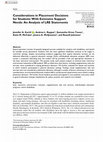Papers by Jessica A McQueston
Teachers College Record, May 1, 2020
Background/Context: Federal laws require equitable access to education for students with disabili... more Background/Context: Federal laws require equitable access to education for students with disabilities through educational placement in the least restrictive environment (LRE). However, research has determined students with significant support needs (SSN) are overrepresented in segregated educational placements. Focus of Study: This study explores justifications of LRE placement decisions for students with SSN through a critical qualitative analysis. We evaluated how individualized education program (IEP) teams interpret LRE and justify placement decisions for students with SSN. Additionally, we sought to understand how the interpretation of LRE permits or restricts access to general education for students with SSN.

Intellectual and Developmental Disabilities, May 24, 2021
Trends in the supplementary aids and services (SAS) written in individualized education programs ... more Trends in the supplementary aids and services (SAS) written in individualized education programs (IEPs) for students with significant disabilities (a) in different educational placements, (b) with and without behavior support plans (BSP), and (c) with and without complex communication needs (CCN) are examined using multivariate analysis of variance. Results show no significant differences in SAS for students across separate, resource, and inclusive placements. Students with BSPs had significantly more collaborative and behavior SAS than those without BSPs. Students with CCN had significantly more social-communication SAS than those whose IEPs indicated little to no communication support needs; however, 51.1% of students with CCN had no social-communication SAS. Findings raise concern around the extent to which SAS are considered before placement decisions, the high frequency of paraprofessional support for students with BSPs, and the low frequency of social-communication SAS written for students with CCN. Implications for policy, practice, and future research are provided.
Journal of disability studies in education, Oct 7, 2022
In this qualitative study, we analyzed the language used by professionals within iep documents fo... more In this qualitative study, we analyzed the language used by professionals within iep documents for students with disabilities. Viewing the iep as a narrative, and using positioning theory as guiding framework, statements of present levels of academic and functional performance in iep s for 88 students in grades K-12 in the United States were analyzed. Findings revealed that students were negatively positioned through

Research and practice for persons with severe disabilities, Feb 1, 2019
Special education consists of specially designed services available for students with disabilitie... more Special education consists of specially designed services available for students with disabilities, and should be available across placements. Students with the most significant disabilities continue to be taught in restrictive settings, despite accumulating evidence suggesting their special education services can be delivered effectively in general education settings. Every individualized education program (IEP) must contain a statement describing how the student will be provided a free and appropriate education in the least restrictive environment. The present study used content analysis to examine least restrictive environment statements of 88 students' IEPs to determine what factors, including supplementary aids and services, were considered in making placement decisions. We further analyzed the classes and activities in which students participated in general education settings. Findings reveal supplementary aids and services were not considered in placement decisions, although a number of factors centering on curricular considerations, environmental demands, student deficit, and personnel requirements were noted in making placement decisions. We further found students primarily participated in non-academic instruction while in general education settings. Implications for policy, practice, and research are included.
McQueston illustrates how peer-mediated strategies were used with the Special Olympics "Young Ath... more McQueston illustrates how peer-mediated strategies were used with the Special Olympics "Young Athletes" program. These modifications allowed teachers to implement this program more readily, thereby promoting the inclusion of students with disabilities. Using pillars of collaborative strategic reading, all group members can contribute to the success of the group, thus disrupting the idea that students with disabilities can receive only help.
Journal of Disability Studies in Education
In this qualitative study, we analyzed the language used by professionals within iep documents fo... more In this qualitative study, we analyzed the language used by professionals within iep documents for students with disabilities. Viewing the iep as a narrative, and using positioning theory as guiding framework, statements of present levels of academic and functional performance in iep s for 88 students in grades K-12 in the United States were analyzed. Findings revealed that students were negatively positioned through the skills that were reported, the data that were reported, and problems located in the student rather in the environment. Implications for policy, practice, and research are provided.

Research and Practice for Persons with Severe Disabilities, 2021
This systematic literature review updates and extends the findings of Hudson and Test’s 2011 revi... more This systematic literature review updates and extends the findings of Hudson and Test’s 2011 review of literature on shared reading, an interactive read-aloud practice, to promote literacy skills for students with extensive support needs (ESN). Thirty-two shared reading studies are assessed and described in terms of literacy skills investigated, intervention methods, materials used, interventionists, and settings in which shared reading has been evaluated for students with ESN. The quality of each included study was analyzed and the assessment of level of research evidence was conducted using systematic processes. Results indicate that there is a moderate level of evidence for shared reading as an intervention to promote comprehension, vocabulary, and emergent literacy skills for students with ESN. Implications for practice and areas of need for future research are presented.

Intellectual and Developmental Disabilities, 2021
Trends in the supplementary aids and services (SAS) written in individualized education programs ... more Trends in the supplementary aids and services (SAS) written in individualized education programs (IEPs) for students with significant disabilities (a) in different educational placements, (b) with and without behavior support plans (BSP), and (c) with and without complex communication needs (CCN) are examined using multivariate analysis of variance. Results show no significant differences in SAS for students across separate, resource, and inclusive placements. Students with BSPs had significantly more collaborative and behavior SAS than those without BSPs. Students with CCN had significantly more social-communication SAS than those whose IEPs indicated little to no communication support needs; however, 51.1% of students with CCN had no social-communication SAS. Findings raise concern around the extent to which SAS are considered before placement decisions, the high frequency of paraprofessional support for students with BSPs, and the low frequency of social-communication SAS written...

The Journal of Special Education, 2018
Supplementary aids and services (SAS) have been a provision in special education law since PL 94-... more Supplementary aids and services (SAS) have been a provision in special education law since PL 94-142, however, almost no guidance has been provided to help teams make decisions about their appropriate selection and use. In this exploratory study, we explore the types of SAS selected for students with significant support needs using a conventional content analysis of individualized education program (IEPs) from 88 students in Grades K–12. Results illustrate the wide variation in types of SAS chosen for students overall. Curricular accommodations and personnel supports were the most commonly identified supports, while supports to assist students to communicate and make meaning of curriculum (e.g., curricular modifications) were less common, as were less intrusive supports such as peer-assisted learning. Implications for policy, practice, and research are provided.

Teachers College Record: The Voice of Scholarship in Education, 2020
Background/Context Federal laws require equitable access to education for students with disabilit... more Background/Context Federal laws require equitable access to education for students with disabilities through educational placement in the least restrictive environment (LRE). However, research has determined students with significant support needs (SSN) are overrepresented in segregated educational placements. Focus of Study This study explores justifications of LRE placement decisions for students with SSN through a critical qualitative analysis. We evaluated how individualized education program (IEP) teams interpret LRE and justify placement decisions for students with SSN. Additionally, we sought to understand how the interpretation of LRE permits or restricts access to general education for students with SSN. Population Students with SSN are those who require support across multiple domains and often have disabilities in the categories of autism, intellectual disability, multiple disabilities, and deaf-blindness. Research Design We used a qualitative methodology situated in a cr...

Research and Practice for Persons with Severe Disabilities, 2019
Special education consists of specially designed services available for students with disabilitie... more Special education consists of specially designed services available for students with disabilities, and should be available across placements. Students with the most significant disabilities continue to be taught in restrictive settings, despite accumulating evidence suggesting their special education services can be delivered effectively in general education settings. Every individualized education program (IEP) must contain a statement describing how the student will be provided a free and appropriate education in the least restrictive environment. The present study used content analysis to examine least restrictive environment statements of 88 students’ IEPs to determine what factors, including supplementary aids and services, were considered in making placement decisions. We further analyzed the classes and activities in which students participated in general education settings. Findings reveal supplementary aids and services were not considered in placement decisions, although ...

Remedial and Special Education
This qualitative multiple case study was part of a larger investigation to examine the processes ... more This qualitative multiple case study was part of a larger investigation to examine the processes that underlie involvement and progress in the general curriculum for students with extensive support needs. We found that general and special educators’ self-efficacy influenced students’ involvement and progress in the general curriculum. Special educators’ self-efficacy was influenced by their teacher preparation, flexibility, and content knowledge; and the district history and political context. General educators’ self-efficacy was influenced by feelings of autonomy, role clarity, and knowledge about inclusive education. Our findings revealed the central importance of teachers’ self-efficacy in supporting the involvement and progress in the general curriculum among students with extensive support needs. Results are discussed in relation to relevant theories of literacy access and inclusion for students with extensive support needs.

The Journal of Special Education
Supplementary aids and services have been a provision in special education law since PL 94-142, h... more Supplementary aids and services have been a provision in special education law since PL 94-142, however, almost no guidance has been provided to help teams make decisions about their appropriate selection and use. In this exploratory study, we explore the types of supplementary aids and services selected for students with significant support needs using a conventional content analysis of Individual Education Program (IEPs) from 88 students in grades K-12. Results illustrate the wide variation in types of supplementary aids and services chosen for students overall. Curricular accommodations and personnel supports were the most commonly identified supports, while supports to assist students to communicate and make meaning of curriculum (e.g., curricular modifications) were less common, as were less intrusive supports such as peer assisted learning. Implications for policy, practice, and research are provided.










Uploads
Papers by Jessica A McQueston